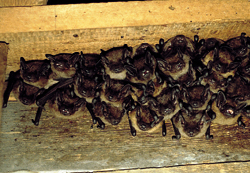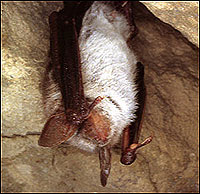The secret life of bats
By Phil Richardson
Roosting and hibernating
Animals need a place to shelter when at rest, away from extremes of temperature, rain or wind, and preferably close to their food supply. Although most bats roost during the daytime high up, some species choose lower sites, even such places as under rocks in deserts. Bats' front hands are not much use for defence from predators, having evolved into wings, and their back legs are often supporting them as they hang, so cannot be used either for kicking or scratching. Accordingly, bats generally try to find a shelter that will give them protection by being inaccessible to possible predators, although many megabats hang out in the open on tree branches. This protection may be because the location is high up or perhaps has a very narrow entrance.

A group of serotines, Eptesicus serotinus, roost against the ridge beam in a house roof-space. (Image: Phil Richardson)
The most commonly used roost sites are cavities and crevices in trees and in caves. Since humans appeared, the bats have also made use of many of our structures, such as the roof spaces of buildings, walls, cellars, mines and tunnels, wartime bunkers, tombs, niches in churches, temples and other old buildings, and crevices in bridges, to serve as roosts where they can rest in safety. Whenever possible, microbats seem to choose dark sites such as those listed above. Bats spend a large proportion of their lives in their roosts, especially in temperate regions where summer days are particularly long.
In temperate areas, two major factors that influence bats in their choice of roosting places are the temperature and humidity of the site in question. Bat embryos develop only slowly when cold, so females choose hot sites when they are pregnant. Males have relatively little need for activity in the spring and summer, so they may be found in cooler roosting sites, such as unheated church buildings and cool tunnels or caves, where they can conserve their stored energy.
Record roosts
In most bat species females gather together to produce young communally. The extreme example of this behaviour among the microbats is that of the Mexican free-tailed bat, Tadarida brasiliensis, whose vast congregations in some caves during the 1960s were estimated to contain as many as 50 million individuals, the largest known gatherings of any mammal. The bats emerge at sunset in a continuous stream, looking like smoke emerging from the cave entrance. This stream stretches out to the far horizon, and still more emerge well into the night. In the morning, returning bats can also create an unforgettable spectacle as they arrive high and suddenly plunge down at breakneck speed back into their roost.
Some megabats, too, gather in spectacular numbers in their camps. In Australia little red flying foxes, Pteropus scapulatus, have formed gatherings containing over 1 million individuals. Such numbers can cause damage to the trees in which they roost from the sheer weight of the bats and from their droppings.
Why do some bats gather in such huge numbers? Clustering can increase the warmth of the whole roost site. There are also advantages gained from putting all the babies in one crèche, as long as it is a safe one. Certainly for bats roosting outside, more than one pair of eyes is useful for defence. Perhaps a more important benefit is that a huge number of bats emerging is likely to confuse any predators that may be waiting outside the roost. Chattering noises can often be heard where bats gather together in the daytime, so communication may be another important reason to gather.
Those bat species that don't form large roosts must find alternative benefits from roosting in smaller numbers.
Bats usually have a number of alternative roost sites to which they can move at different times of the year, enabling them to select the most suitable temperature for their particular needs. Large underground sites typically have a range of different temperatures and humidities between the entrance and the deepest part, and bats use different sections accordingly. In house roofs, though many species can cope with temperatures of 40°C, it sometimes becomes too hot even for bats, so they move deeper into the structure where it is cooler, such as into the cavity wall. In the Old World tropics, fruit bats hanging out in the open do not have this opportunity, and may fan themselves with their wings to cool their bodies during the hottest part of the day.
Unlike most other mammals, bats do not furnish their resting places with soft or warm material, nor do they chew at the entrance hole to enlarge it; they simply enter and hang themselves up. If a site does not suit them, then they move to another location. During the course of the summer in temperate areas, roosts of bats will regularly move between many different sites for reasons as yet unknown, although the changing conditions at each site must play an important part.
Typical roost sites:
- In trees - Most megabats form large gatherings, known as camps, in specially selected trees, where they hang from the upper branches. Microbats prefer to hide away and enter holes and crevices in the trunk or branches. Some hang out in the open or under leaves, but have cryptic colouring to camouflage them.
- Underground - In large sites, bats may hang from the highest part of the roof of a cave or other underground site, knowing that they are out of reach of predators, but in smaller sites they may squeeze into a crevice to provide protection from attack or to avoid becoming chilled by any breezes that may be blowing through a tunnel.
- In buildings - As with other sites, an important factor determining the choice of site is to keep out of harm's way, so bats in a roof space usually roost high up on the ridge beam, under the eaves or squeezed between the outer roof covering and any lining; some wriggle into the cavity between the inner and outer walls, some find safety between stones or bricks where the mortar is missing, while others are even able to nestle within the expansion joints on bridges. A small bat can enter a roosting site through a gap as little as 1cm wide.
Night roosts
Bats also use night roosts, places where they can rest temporarily between feeding bouts. These may be places that are sometimes also used in the day or for winter hibernation. In some instances, they may even be sited out in the open, for example on the trunk of a tree, where the bats use the dark of the night to hide.
Locating roosts
Finding roosts can be difficult, but many species of microbats swarm around their roost sites before entering on their return in the early morning, and this activity is very obvious and visible. With Old World fruit bats, locating roosts is generally much easier. All an investigator has to do is follow his or her nose. Large camps of fruit bats can be remarkably pungent.
Hibernation and hibernacula
In temperate areas of the world, the cold weather typical of the winter months results in few insects being available to sustain the microbats. To cope with this seasonal famine, the bats are able to hibernate. They can survive for months in this state just on the stores of fat they have already built up in their bodies. As with their summer roosts, they choose their winter roosting places (called hibernacula) to provide the optimum environment for their hibernation.

A greater mouse-eared bat, Myotis myotis, hibernating in a cave. In summer, roosts of this species can contain up to 2,000 females. (Image: Phil Richardson)
Different species choose slightly different conditions, but the temperature is generally below 10°C. The site must be insulated from any changes in temperature outside, so the bats often select underground sites or crevices deep within an old tree. High humidity is also essential, as bats can easily dehydrate during hibernation.
Also, once they enter hibernation, they are defenceless against danger, as it takes half an hour or more for a bat to revert back to its normal alertness after being woken. For this reason they choose even more inaccessible places than in summer, where they may hibernate singly or form clusters. They allow their body temperatures to drop almost to that of the environment around them; if it becomes too cold, they move to another roosting site with more suitable conditions.
Microbats may swarm around a roost before entering early in the morning, but in autumn in temperate regions some have also been seen swarming around the entrance of hibernacula, flying round and round, often in relatively large numbers. As this happens before the period when the bats hibernate, it appears that their behaviour is linked to information-gathering or breeding strategies. This is yet another area of the study of bat behaviour where knowledge is lacking and there are opportunities for research.
Toolbox

The Museum's smallest members of staff are our flesh-eating beetles, Dermestes maculates, who strip carcasses to the bone.
